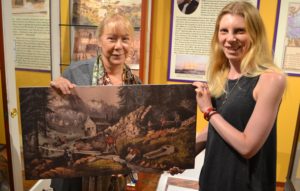
Benicia Historical Museum Executive Director Elizabeth d’Huart (left) and special projects associate Katelynn Burmark hold up a painting of prospectors panning for gold along the Sacramento River during the California Gold Rush. Benicia’s role in the historical event will be showcased in the new temporary exhibit “Benicia’s Gold Rush Story” beginning Tuesday. (Photo by Nick Sestanovich)
The discovery of gold at Sutter’s Mill in 1848 triggered a seven-year population influx and economic boom in the appropriately named Golden State for what became known as the California Gold Rush. Benicia played a part in the Gold Rush, as can be seen in the upcoming Benicia Historical Museum exhibition “Benicia’s Gold Rush Story,” which opens Tuesday.
Museum Executive Director Elizabeth d’Huart said she wanted an exhibit that captured the imaginations of residents and visitors but also reinforced the museum’s mission statement, “The history of California is written in the story of Benicia.”
“One of the major stories is the Gold Rush,” she said. “Everybody, including folks from other countries, is fascinated by the whole phenomenon of the Gold Rush, and there are so many important elements about the Gold Rush that tie into Benicia’s history.”
Although a number of towns claim that their locale was where news about the secret of gold was discovered, d’Huart said there have been several verified historical accounts that lend credence to the belief that the secret was revealed at the Von Pfister General Store by a man journeying from Sutter’s Mill to Monterey with a sample of gold nuggets in hand. The store, located in an alley between C and D streets, became a place for prospectors from Benicia and other places to buy supplies before they embarked up to the gold fields near Sutter’s Mill. During California’s peak immigration period between 1849 and 1852, Benicia became a port town for people who either changed vessels or transferred to overland transportation. It was during this time that Benicia co-founder Robert Semple began operating a ferry business, in which he made $50 a day. Benicia also offered lodging to miners in the winter months and offered several hotels along First Street.
“When you look at the goods that were available in Von Pfister’s Adobe Store, it gives a really interesting mirror to the kind of life that people were living in the gold fields and in the local area,” d’Huart said.
Additionally, d’Huart said the Yuba Manufacturing Company which operated in Benicia for a long time began in the mining sector on the Yuba River. The company was not only one of the largest industries in Benicia for several decades but also one of the largest companies west of the Mississippi River.
The centerpiece of the exhibit is an operational model of a Yuba dredge, a large apparatus which dug for gold along the river. D’Huart said everyone who has seen it has been “fascinated” by it.
In addition to the dredge, the exhibit has information on Captain Edward von Pfister and his store, maps of the overseas and overland gold routes to California, a map of California’s gold fields and supply points— including Benicia, and descriptions of various gold mining techniques from hydraulic mining to sluice boxes to panning. The exhibit also contains a number of artifacts from the museum’s archives, including tools to determine the weight and purity of the gold, gold refining items and artifacts used to pan for gold. D’Huart said these items were largely discovered in and around dig sites near the Von Pfister Building.
D’Huart hopes visitors will learn not only about Benicia’s role in the Gold Rush but also California’s history as a whole.
“I want them to understand how important Benicia is to every single iconic movement and event that shaped early California history,” she said. “It’s unfortunate that a lot of our history is not physically evident, but it is there and we need to appreciate it and be inspired by it.”
The opening reception for “Benicia’s Gold Rush Story” will take place from 5:30 to 7:30 p.m. Tuesday, July 31. There will be a no-host bar and free bags of Gold Mine Bubble Gum Nuggets. There will also be an operation of the Yuba dredge model. Admission is free.
The exhibit will be on display through at least 2019. The museum is located at 2060 Camel Road. For more information, call 745-5435 or visit beniciahistoricalmuseum.org.






Leave a Reply